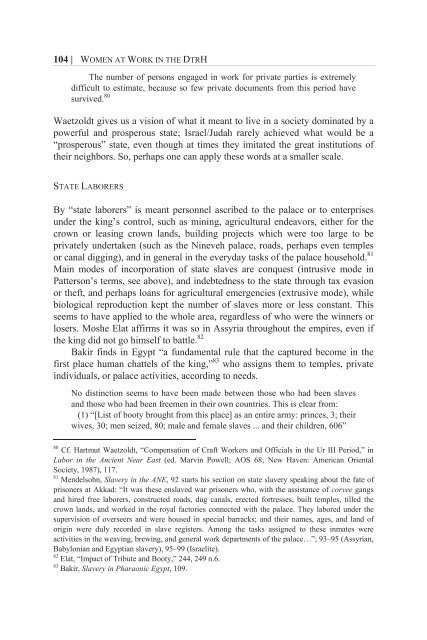Women at Work in the Deuteronomistic History - International Voices ...
Women at Work in the Deuteronomistic History - International Voices ...
Women at Work in the Deuteronomistic History - International Voices ...
Create successful ePaper yourself
Turn your PDF publications into a flip-book with our unique Google optimized e-Paper software.
104 | WOMEN AT WORK IN THE DTRH<br />
The number of persons engaged <strong>in</strong> work for priv<strong>at</strong>e parties is extremely<br />
difficult to estim<strong>at</strong>e, because so few priv<strong>at</strong>e documents from this period have<br />
survived. 80<br />
Waetzoldt gives us a vision of wh<strong>at</strong> it meant to live <strong>in</strong> a society dom<strong>in</strong><strong>at</strong>ed by a<br />
powerful and prosperous st<strong>at</strong>e; Israel/Judah rarely achieved wh<strong>at</strong> would be a<br />
“prosperous” st<strong>at</strong>e, even though <strong>at</strong> times <strong>the</strong>y imit<strong>at</strong>ed <strong>the</strong> gre<strong>at</strong> <strong>in</strong>stitutions of<br />
<strong>the</strong>ir neighbors. So, perhaps one can apply <strong>the</strong>se words <strong>at</strong> a smaller scale.<br />
STATE LABORERS<br />
By “st<strong>at</strong>e laborers” is meant personnel ascribed to <strong>the</strong> palace or to enterprises<br />
under <strong>the</strong> k<strong>in</strong>g’s control, such as m<strong>in</strong><strong>in</strong>g, agricultural endeavors, ei<strong>the</strong>r for <strong>the</strong><br />
crown or leas<strong>in</strong>g crown lands, build<strong>in</strong>g projects which were too large to be<br />
priv<strong>at</strong>ely undertaken (such as <strong>the</strong> N<strong>in</strong>eveh palace, roads, perhaps even temples<br />
or canal digg<strong>in</strong>g), and <strong>in</strong> general <strong>in</strong> <strong>the</strong> everyday tasks of <strong>the</strong> palace household. 81<br />
Ma<strong>in</strong> modes of <strong>in</strong>corpor<strong>at</strong>ion of st<strong>at</strong>e slaves are conquest (<strong>in</strong>trusive mode <strong>in</strong><br />
P<strong>at</strong>terson’s terms, see above), and <strong>in</strong>debtedness to <strong>the</strong> st<strong>at</strong>e through tax evasion<br />
or <strong>the</strong>ft, and perhaps loans for agricultural emergencies (extrusive mode), while<br />
biological reproduction kept <strong>the</strong> number of slaves more or less constant. This<br />
seems to have applied to <strong>the</strong> whole area, regardless of who were <strong>the</strong> w<strong>in</strong>ners or<br />
losers. Moshe El<strong>at</strong> affirms it was so <strong>in</strong> Assyria throughout <strong>the</strong> empires, even if<br />
<strong>the</strong> k<strong>in</strong>g did not go himself to b<strong>at</strong>tle. 82<br />
Bakir f<strong>in</strong>ds <strong>in</strong> Egypt “a fundamental rule th<strong>at</strong> <strong>the</strong> captured become <strong>in</strong> <strong>the</strong><br />
first place human ch<strong>at</strong>tels of <strong>the</strong> k<strong>in</strong>g,” 83 who assigns <strong>the</strong>m to temples, priv<strong>at</strong>e<br />
<strong>in</strong>dividuals, or palace activities, accord<strong>in</strong>g to needs.<br />
No dist<strong>in</strong>ction seems to have been made between those who had been slaves<br />
and those who had been freemen <strong>in</strong> <strong>the</strong>ir own countries. This is clear from:<br />
(1) “[List of booty brought from this place] as an entire army: pr<strong>in</strong>ces, 3; <strong>the</strong>ir<br />
wives, 30; men seized, 80; male and female slaves ... and <strong>the</strong>ir children, 606”<br />
80<br />
Cf. Hartmut Waetzoldt, “Compens<strong>at</strong>ion of Craft <strong>Work</strong>ers and Officials <strong>in</strong> <strong>the</strong> Ur III Period,” <strong>in</strong><br />
Labor <strong>in</strong> <strong>the</strong> Ancient Near East (ed. Marv<strong>in</strong> Powell; AOS 68; New Haven: American Oriental<br />
Society, 1987), 117.<br />
81<br />
Mendelsohn, Slavery <strong>in</strong> <strong>the</strong> ANE, 92 starts his section on st<strong>at</strong>e slavery speak<strong>in</strong>g about <strong>the</strong> f<strong>at</strong>e of<br />
prisoners <strong>at</strong> Akkad: “It was <strong>the</strong>se enslaved war prisoners who, with <strong>the</strong> assistance of corvee gangs<br />
and hired free laborers, constructed roads, dug canals, erected fortresses, built temples, tilled <strong>the</strong><br />
crown lands, and worked <strong>in</strong> <strong>the</strong> royal factories connected with <strong>the</strong> palace. They labored under <strong>the</strong><br />
supervision of overseers and were housed <strong>in</strong> special barracks; and <strong>the</strong>ir names, ages, and land of<br />
orig<strong>in</strong> were duly recorded <strong>in</strong> slave registers. Among <strong>the</strong> tasks assigned to <strong>the</strong>se <strong>in</strong>m<strong>at</strong>es were<br />
activities <strong>in</strong> <strong>the</strong> weav<strong>in</strong>g, brew<strong>in</strong>g, and general work departments of <strong>the</strong> palace…”; 93–95 (Assyrian,<br />
Babylonian and Egyptian slavery), 95–99 (Israelite).<br />
82<br />
El<strong>at</strong>, “Impact of Tribute and Booty,” 244, 249 n.6.<br />
83<br />
Bakir, Slavery <strong>in</strong> Pharaonic Egypt, 109.




